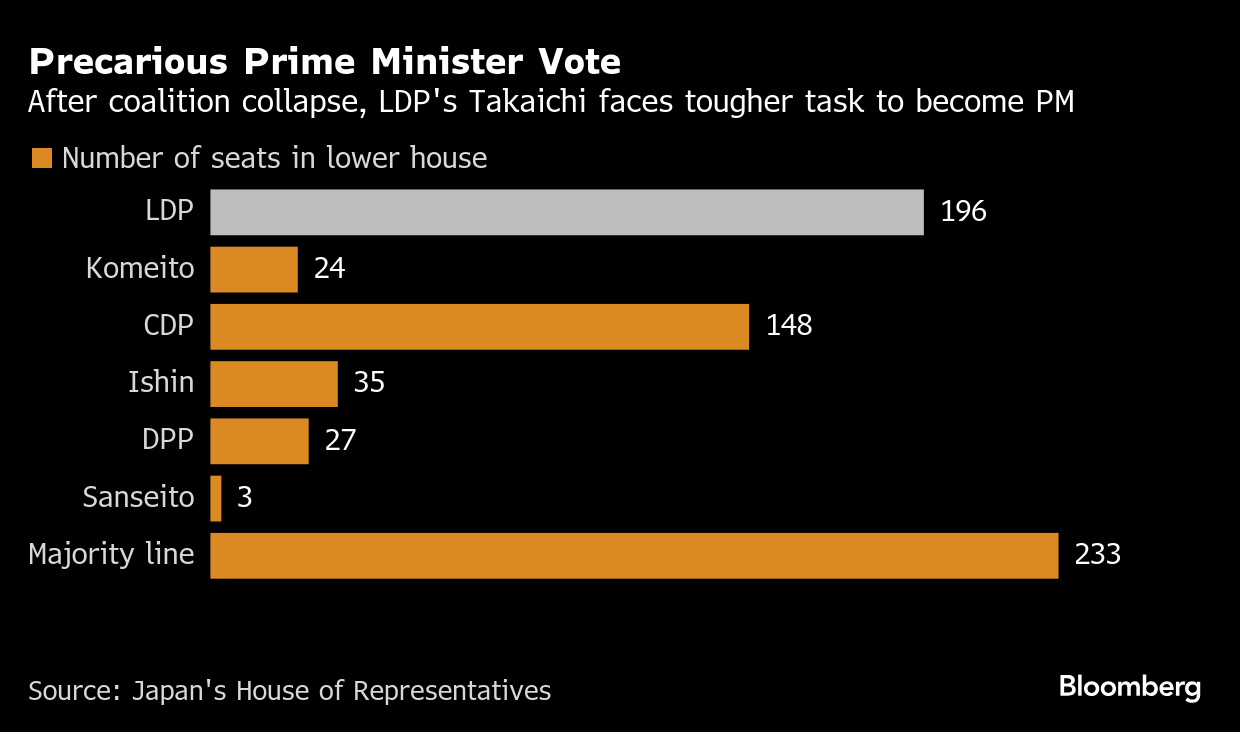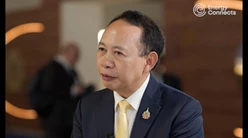Japan’s Surprise Kingmaker Tamaki Has Shot at Becoming PM
(Bloomberg) -- Less than a year ago, Yuichiro Tamaki was fighting to retain the leadership of his own opposition party amid reports of an extramarital affair. Now, the 56-year-old athletics fan is in the running to lead the nation, with the identity of the next administration largely in his grasp.
The collapse of the ruling coalition last week has catapulted Tamaki into a position where he could become prime minister with the support of three opposition parties including his Democratic Party for the People. That’s a potential outcome that seemed like wishful thinking just days ago as the ruling party’s new leader Sanae Takaichi was getting lauded as Japan’s first female prime minister-in-waiting.
Tamaki was due to meet the leaders from the Constitutional Democratic Party and the Japan Innovation Party at 4 p.m. on Wednesday. The three opposition party leaders will assess the scope for cooperation around a single candidate to field against Takaichi in an upcoming parliamentary vote to decide the prime minister.
The DPP leader is in pole position to be that alternative. The three parties’ combined 210 seats in the lower house mean he would be on track to win that vote if the LDP can’t find any additional votes following the loss of its coalition partner Komeito. Whoever becomes prime minister will then form the next government.

“I would like to make Japan a country full of hope once again,” Tamaki said Tuesday as talks between the opposition parties continued. “Currently, young people and the working generations have little hope, or rather, they have no hope at all, and I believe that it is my important role as a politician to change this.”
Tamaki is a former Finance Ministry official who wants a higher tax-free income allowance, a lower sales tax and slower Bank of Japan interest rate hikes. The popularity of Tamaki and his party has mushroomed over the past year or so as his strategy of focusing on increasing take-home pay resonated with voters of working age.
His party, alongside the far-right Sanseito, are the rising newcomers in Japan’s political realm. They are political parties that are appealing to under 50s disillusioned by the failure of LDP’s efforts to address their concerns over the rising cost of living, the growing welfare burden of an aging society and, in the case of Sanseito voters, the influx of foreigners.
While both parties gained seats in the July upper house election, it’s the more powerful lower house that will ultimately decide who becomes premier, and there the DPP has 27 seats compared with Sanseito’s three.
Tamaki already leveraged his party’s presence in the lower house to broker a deal with the LDP last year over raising the tax-free income threshold to ¥1.6 million ($10,500) with an intention to eventually reach ¥1.78 million. Despite the Finance Ministry saying the measure could cost up to ¥8 trillion in lost revenue if applied across the board, the minority ruling coalition at the time had to stomach the demand to ensure the passage of budgets. Now Tamaki can go even further by replacing the LDP altogether.
The DPP’s expansionary fiscal stance and caution on monetary policy normalization suggest that a Tamaki premiership would keep the yen in a weak position and put a greater burden on the nation’s finances if the extra economic growth the party promises doesn’t materialize.

In the July election, the DPP called for the lowering of the sales tax to 5% for all goods until real wages rise in a sustained manner, removing gasoline taxes and renewable energy charges on electricity bills. These measures aimed to boost households’ purchasing power.
As part of its “future-orientated active financing,” the party said it would issue ¥5 trillion of “education bonds” each year to help support child rearing. The party said it would look for a diverse range of funding options including turning some of the BOJ’s holdings of government debt into perpetual bonds.
To bring about a unified candidacy, the DPP and the CDP would have to overcome their differences on defense and nuclear power. Tamaki wants the CDP to become more open to restarting shuttered nuclear plants and to align on security issues. Tamaki’s DPP supports the defense build-up initiated by the LDP and the right to counter-strike threats.
Likely recalling the instability of a 1993 opposition coalition that briefly ousted the LDP but quickly squabbled on policy, Tamaki is insisting that the parties must start on the same page.
The talks could easily break down, ending Tamaki’s chances and likely clearing the way for Takaichi to become prime minister. An alternative scenario is that the LDP offer concessions to Tamaki’s party including a cabinet position in return for ad-hoc support on policies and a Takaichi premiership.
Still, that’s an outcome that likely looks far less attractive to a politician with a shot at leading the nation.
Long-Jumper
Tamaki is from Kagawa on Japan’s fourth-largest island, Shikoku. The island is famous for its udon noodles, pilgrimage routes and the Awa-odori dance festival. Tamaki, who was a keen decathlete as a student, has made playful reference to his need to run, cycle and lift weights to balance his appetite for those noodles. He plays piano and guitar to satisfy his creative muse.
His elite trajectory saw him pass through the University of Tokyo, the Finance Ministry and Harvard Kennedy School. He joined the ministry in 1993, the same year the dominant LDP lost power for the first time since its formation.
On the wall in his office is a framed replica of calligraphy by Masayoshi Ohira, an LDP heavyweight from his home prefecture who was prime minister from 1978 to 1980. Its six characters mean: When you keep calm, heaven and earth will open up.
While the LDP may still hope to win Tamaki over to its side in 2025, following their policy collaboration the previous year, the current decision he faces isn’t the first time he has needed to choose between the LDP and the opposition. When he opted for a career in politics in 2005, Tamaki was offered party candidacies by both the LDP and its opposition rival, the Democratic Party of Japan.
At that time he selected the DPJ, but he failed to win the Kagawa seat at his first try. He was successful second time around when the party ousted the LDP in 2009 in a historic election landslide. By the time the LDP had wrestled back power in late 2012, Tamaki had already reached the position of DPJ deputy secretary-general.
Like other former members of the DPJ, Tamaki has progressed through an array of splinter parties since then, until taking the full reins of the DPP in 2020. A coalition with the CDP and Ishin would reunite him with some of those senior DPJ leaders, including former Prime Minister Yoshihiko Noda and former Finance Minister Seiji Maehara.
Tamaki’s knack for boiling down his policy message to digestible bites via social media has struck a chord with younger voters. He runs his own YouTube channel, and is happy to talk with rolled up sleeves on topics ranging from the state of government debt to the Olympics.
That’s made him a more forward-looking choice for the opposition to coalesce around than Noda of the CDP. Noda stood down as premier in 2012 after overseeing the first rise in the sales tax in over a decade, an unpopular move that sits awkwardly with his current party’s stance on temporarily lowering it. Noda has also rated lower than Tamaki in opinion polls on who should be the next premier.
While the CDP is one of the driving forces of opposition efforts to coalesce around a single candidate, Noda himself appears to recognize his own limitations and has expressed openness to a Tamaki bid.
Tamaki is not without his own blemishes. His leadership of the DPP was suspended for three months in the last year after he essentially admitted reports of an extramarital affair. While he has played the familiar gambit of delineating his private life from his political life, the deception will likely cast a shadow over his credibility for some voters.
Still, the party’s acceptance of his contrition and his return to the helm of the DPP point to a reliance on his political charisma, sharp messaging and potential as a national leader.
(Updates with the time of the three-way meeting. An earlier version of this story was updated to amend the current number of DPP members in the lower house.)
©2025 Bloomberg L.P.





